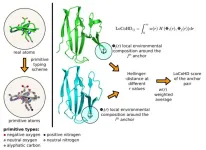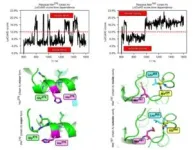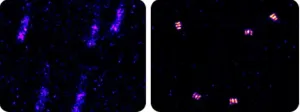A new Hungarian method may aid protein research
The new technique, called LoCoHD (Local Composition Hellinger Distance), also includes the chemical information of the atoms
2024-05-29
(Press-News.org)
In a paper recently published in Nature Communications, the HUN-REN-ELTE Protein Modeling Research Group (Institute of Chemistry) has laid the foundations for a mathematical method, allowing the computer-assisted comparison of the three-dimensional structures of proteins. The method is unique in that while the alternatives available so far only took into account the position of the atoms, the new technique, called LoCoHD (Local Composition Hellinger Distance), also includes the chemical information of the atoms.
Proteins are molecular machines that carry out processes necessary for cells to function, acting as molecular switches, transcribing information from DNA, transporting small and large molecules and regulating metabolism related chemical reactions. However, for all this to succeed, the protein in question must have the right spatial conformation, i.e. its own, correct 3D arrangement. Several experimental methods (X-ray crystallography, nuclear magnetic resonance spectroscopy, cryo-electron microscopy) are available to determine the arrangement of atoms in a protein, and over the last few decades protein researchers have discovered the shape of nearly 220,000 proteins. These results increasingly demand the development of computational methods capable of analyzing these arrangements.
One such method is the algorithm called LoCoHD, developed by Zsolt Fazekas, a PhD candidate at the ELTE Hevesy György School of Chemistry and a researcher in Dr. András Perczel's research group. The algorithm compares local environments around amino acids in proteins based on their chemical nature (e.g. elemental composition, charge, hydrophobicity, etc.). The method decides on a simple scale of 0 to 1 how different the structures in question are from each other. Values close to 0 suggest a high similarity between atomic arrangements and chemical properties, while values close to 1 indicate that the proteins being compared may have very different properties. The resulting numerical value (a so-called metric) can thus be used to obtain new information about the system under study.
The algorithm uses a multi-step protocol to generate the number representing the structural differences. In the first step, it converts real atoms in the protein into so-called primitive atoms. These can be represented as virtually labeled positionso whose labels tell the chemical nature of the original atom. So, for example, an primitive atom can be a "positively charged nitrogen", a "negatively charged oxygen", a "neutrally charged oxygen", an "aromatic carbon", etc. The labels are generated according to a so-called primitive typing scheme, which tells us in a tabulated manner how to convert real atoms into primitive atoms. The user can freely specify this table, fixing the chemical resolution of the method. The second step is to determine the reference points of the comparison by selecting a subset of primitive atoms. These selected special primitive atoms are called the anchor atoms. For each selected anchor atom pair, the algorithm performs a comparison step, the result of which gives the dissimilarity measure we want. These numbers can be used at a local level, or they can be averaged into a single descriptor characterizing the whole protein.
In the study, published in the prestigious journal Nature Communications, the researchers highlighted that the method can also be used in the biannual CASP (Critical Assessment of Protein Structure Prediction) competitions, which is a well known competition in the field of protein research. During this event, competitors use different algorithms to model the shape of proteins having yet unpublished structures. CASP judges use a number of structure comparison methods to evaluate the contenders, but none of these take into account the chemistry of the local amino acid environments. Using data from the 2020 CASP14 competition, the researchers have now performed comparative analysis of several modeled proteins, including the structures predicted by the artificial-intelligence-based AlphaFold2 method. Among these, they highlighted the analysis of a protein from the SARS-CoV-2 virus called ORF8. In the modeled structures of this protein, amino acid environments were identified that differ significantly in their interaction patterns from the environments found in the experimental structure.
In addition to studying static structures, the researchers also tested whether the method is suitable for analyzing the internal motion of proteins. They used simulations capable of reproducing molecular motions and data extracted from structural ensembles. One of the systems under study was the podocin protein, which performs vital functions in the kidney and whose mutations can cause severe, often fatal conditions. The LoCoHD method was used to identify amino acids in the protein that undergo major chemical-environmental changes during the movement of podocin, which can affect both its structure and function. Similarly, the LoCoHD method has been applied successfully in the study of the HIV-1 capsid protein, in which an amino acid critical for the formation of the viral envelope has been identified.
These results are not only research curiosities, but by studying protein structures more effectively, we can get closer to better understanding the pathogens causing severe diseases and to developing effective drugs and therapeutics.
END
[Attachments] See images for this press release:


ELSE PRESS RELEASES FROM THIS DATE:
2024-05-29
When trying to measure molecular structures with nanometer precision, every bit of noise shows up in the data: someone walking past the microscope, tiny vibrations in the building and even the traffic outside. A new processing technique removes noise from optical microscope data in real time, allowing scientists to track individual molecules over 10 times more precisely than was possible before.
A team of bioengineering researchers at the University of Illinois Urbana-Champaign has introduced an algorithm called adaptive intersection maximization, or AIM, that removes high-frequency ...
2024-05-29
Researchers at Rice University have revealed a previously unknown function of opioid receptors in the development of the enteric nervous system (ENS), often referred to as the “brain in the gut.” This discovery challenges conventional understanding of opioid receptors, shedding new light on their significance beyond pain management and addiction.
Led by Rosa Uribe, an assistant professor of biosciences at Rice and a Cancer Prevention and Research Institute of Texas (CPRIT) Scholar, the research team identified the genes critical for ENS development by conducting a series of experiments using zebrafish ...
2024-05-29
CLEVELAND - Researchers from Cleveland Clinic and IBM recently published findings in the Journal of Chemical Theory and Computation that could lay the groundwork for applying quantum computing methods to protein structure prediction. This publication is the first peer-reviewed quantum computing paper from the Cleveland Clinic-IBM Discovery Accelerator partnership.
For decades, researchers have leveraged computational approaches to predict protein structures. A protein folds itself into a structure that determines how it functions and binds to other ...
2024-05-29
WHAT: Researchers have, for the first time, visualized the full network of blood vessels across the cortex of awake mice, finding that blood vessels rhythmically expand and contract leading to “waves” washing across the surface of the brain. These findings, funded by the National Institutes of Health (NIH), improve the understanding of how the brain receives blood, though the function of the waves remains a mystery.
A network of elastic and actively pumping vessels carrying oxygenated blood span the surface of the brain before entering the cortex. There, they feed into a second network of capillaries that supply oxygen deeper into ...
2024-05-29
More out-of-state women, largely from Texas and Alaska, are traveling to Washington state to obtain an abortion than was the case before the U.S. Supreme Court struck down the constitutional right to abortion, according to research published today in JAMA Network Open.
The study tracked the number of abortions performed at the Cedar River Clinics, a large network of care sites in Washington state, both before and after the 2022 Dobbs decision.
Researchers found a 50% increase in out-of-state patients (from 4% to 6%) and documented an average one-week delay in care for all patients seeking ...
2024-05-29
SAN ANTONIO (May 29, 2024) – SARS-CoV-2, the virus that causes COVID-19 disease, continues to evolve and evade current vaccine and therapeutic interventions. A consortium of scientists at Texas Biomedical Research Institute (Texas Biomed), the University of Alabama at Birmingham (UAB) and Columbia University have developed a promising new human monoclonal antibody that appears a step closer to a universal antibody cocktail that works against all strains of SARS-CoV-2.
“This antibody worked against the original SARS-CoV-2 strain, Omicron and SARS-CoV, providing ...
2024-05-29
EMBARGOED FOR RELEASE UNTIL 4 P.M. ET, WEDNESDAY, MAY 29, 2024
MINNEAPOLIS – While older drugs for epilepsy, taken while pregnant, have been shown in previous research to affect the creative thinking of children, a new study finds no effects on creativity for children born to those taking newer epilepsy drugs. This study is published in the May 29, 2024, online issue of Neurology®, the medical journal of the American Academy of Neurology.
Overall, the study found no effects on the children’s creative abilities or their executive function, which is a person’s ability to plan, focus, and manage multiple tasks. However, when ...
2024-05-29
EMBARGOED FOR RELEASE UNTIL 4 P.M. ET, WEDNESDAY, MAY 29, 2024
MINNEAPOLIS – People who report early memory problems and whose partners also suspect they have memory problems have higher levels of tau tangles in the brain, a biomarker associated with Alzheimer’s disease, according to a study published in the May 29, 2024, online issue of Neurology®, the medical journal of the American Academy of Neurology.
Subjective cognitive decline is when a person reports memory and thinking problems before any decline is large enough to show up on standard tests.
“Understanding the earliest signs of Alzheimer’s disease is even more important ...
2024-05-29
Researchers found that reports from patients and their partners about cognitive decline were associated with the accumulation of tau, a hallmark of Alzheimer’s disease
A new study adds further evidence that when a patient or family member notices signs of persistent memory loss, it’s important to speak with a doctor. While there are many reasons why someone’s memory may change, researchers from Mass General Brigham who are studying patients prior to diagnosis with Alzheimer’s disease found changes in the brain when patients and their study partners—those who could answer questions about their ...
2024-05-29
In a new paper in Science Advances on May 29, researchers at JPMorgan Chase, the U.S. Department of Energy’s (DOE) Argonne National Laboratory and Quantinuum have demonstrated clear evidence of a quantum algorithmic speedup for the quantum approximate optimization algorithm (QAOA).
This algorithm has been studied extensively and has been implemented on many quantum computers. It has potential application in fields such as logistics, telecommunications, financial modeling and materials science.
“This work is a significant step towards reaching quantum advantage, ...
LAST 30 PRESS RELEASES:
[Press-News.org] A new Hungarian method may aid protein research
The new technique, called LoCoHD (Local Composition Hellinger Distance), also includes the chemical information of the atoms




